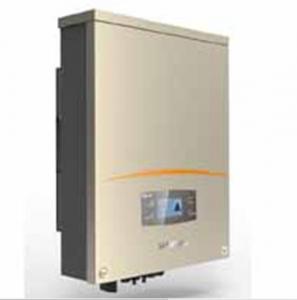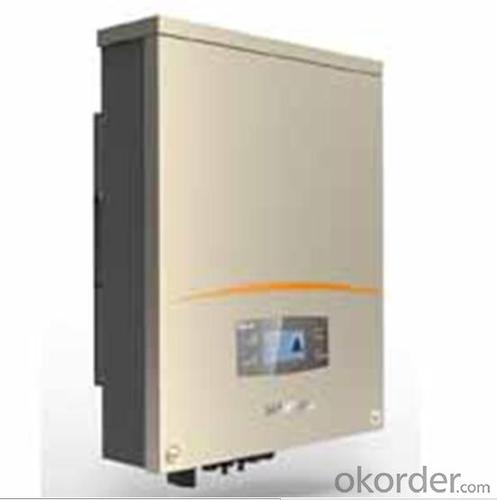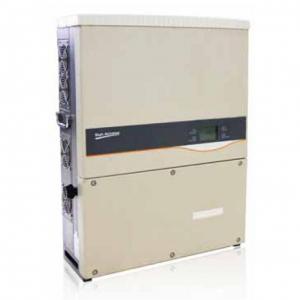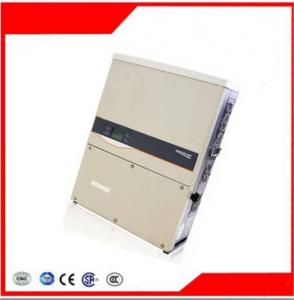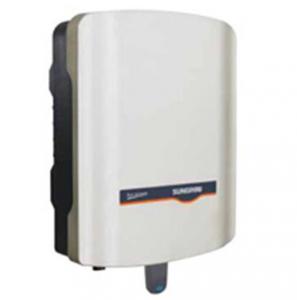24V Solar Inverter Solar Photovoltaic Grid-Connected Inverter SG6KTL-EC
- Loading Port:
- China Main Port
- Payment Terms:
- TT or LC
- Min Order Qty:
- 5000 unit
- Supply Capability:
- 3000000 unit/month
OKorder Service Pledge
OKorder Financial Service
You Might Also Like
1. Structure of Solar Photovoltaic Grid-Connected Inverter SG6KTL-EC Description
A solar inverter, or PV inverter, or Solar converter, converts the variable direct current (DC) output of a photovoltaic (PV) solar panel into a
utility frequency alternating current (AC) that can be fed into a commercial electrical grid or used by a local, off-grid electrical network. It is
a critical BOS–component in a photovoltaic system, allowing the use of ordinary AC-powered equipment. Solar inverters have special
functions adapted for use with photovoltaic arrays, including maximum power point tracking and anti-islanding protection.
2. Main Features of the Solar Photovoltaic Grid-Connected Inverter SG6KTL-EC
• Flexible design due to dual MPPT tracking that is equipped to obtain full nominal power, 3-phase supply
• High energy yield due to maximum efficiency up to 98.1%﹒competitive wholesale price.
• Low noise levels and internal consumption due to natural cooling
• Integrated theft protection﹒AC Voltage Range:150V-550Vac
• Access to Home WiFi system and enjoy cloud services via smart phones
• Integrated power management function, easy to receive the adjustable command from grid
• Extensive communication: RS-485, Ethernet, WLAN / WiFi, 4 digital inputs for ripple control receivers
• Product certification: TÜV, VDE 0126-1-1, EN 62109-1/-2, CE, G83/1, VDE-AR-N 4105
• Manufacturer certification: ISO 9001, ISO 14001, OHSAS 18000
3. Solar Photovoltaic Grid-Connected Inverter SG6KTL-EC Images

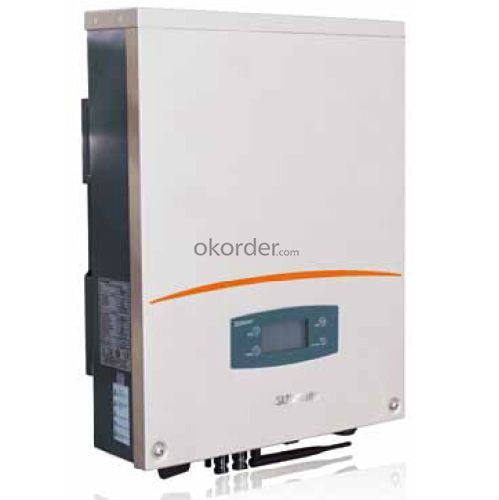

4. Solar Photovoltaic Grid-Connected Inverter SG6KTL-EC Specification
Input Side Data |
|
Max. PV input power | 6312W |
Max. PV input voltage | 1000V |
Startup voltage | 250V |
Nominal input voltage | 610V |
MPP voltage range | 200~900V |
MPP voltage range for nominal power | 320~800V |
No. of MPPTs | 2 |
Max. number of PV strings per MPPT | 1/1 |
Max. PV input current | 19.8A(9.9A/9.9A) |
Max. current for input connector | 10A |
Short-circuit current of PV input | 24.8A(12.4A/12.4A) |
Output Side Data |
|
Nominal AC output power | 6000W |
Max AC output power(PF=1) | 6000W |
Max. AC output apparent power | 6000VA |
Max. AC output current | 8.7A |
Nominal AC voltage | 3/N/PE,230/400Vac |
AC voltage range | 310~480Vac(May vary as per corresponding country's grid standard) |
Nominal grid frequency | 50Hz |
Grid frequency range | 45~55Hz(May vary as per corresponding country's grid standard) |
THD | < 3 % (Nominal power) |
DC current injection | <0.5 %In |
Power factor | >0.99@default value at nominal power, |
Protection |
|
Anti-islanding protection | Yes |
LVRT | No |
DC reverse connection protection | Yes |
AC short circuit protection | Yes |
Leakage current protection | Yes |
DC switch | Integrated |
DC fuse | No |
Overvoltage protection | III |
System Data |
|
Max. efficiency | 98.1% |
Max. European efficiency | 97.3% |
Isolation method | Transformerless |
Ingress protection rating | IP65 |
Night power consumption | <1W |
Operating ambient temperature range | -25~60℃(>45℃ derating) |
Allowable relative humidity range | 0~100% |
Cooling method | Natural cooling |
Noise | ≤29dB |
Max. operating altitude | 2000m |
Display | Graphic LCD |
Communication | Ethernet,RS485(RJ45 connector),4×Digital Inputs,Wifi |
DC connection type | MC4 |
AC connection type | Plug and play connector |
Certification | VDE0126-1-1,EN62109-1, |
Mechanical Data |
|
Dimensions(W×H×D) | 403×518×190mm |
Mounting method | Wall bracket |
Weight | 22kg |
5. FAQ of Solar Photovoltaic Grid-Connected Inverter SG6KTL-EC
Q1. What is the difference between inverter and solar inverter?
A1. Inverter only has AC inpput, but solar inverter both connect to AC input and solar panel, it saves more power.
Q2. What is the difference between MPPT&PWM?
A2. MPPT has higher efficiency, it can track the max power point and won't waste energy.
- Q: How does a solar inverter handle variations in battery charge levels?
- A solar inverter manages variations in battery charge levels by continuously monitoring the battery voltage and adjusting the charging and discharging rates accordingly. It optimizes the power flow and ensures that the battery is neither overcharged nor depleted, thus maximizing its lifespan and efficiency.
- Q: What is the purpose of a solar inverter in a solar power system?
- The purpose of a solar inverter in a solar power system is to convert the direct current (DC) electricity produced by the solar panels into alternating current (AC) electricity that can be used to power electrical devices in homes and businesses.
- Q: What is the role of a solar inverter in a solar-powered ventilation system?
- The role of a solar inverter in a solar-powered ventilation system is to convert the direct current (DC) electricity generated by the solar panels into alternating current (AC) electricity, which is the type of electricity used in most household appliances. This conversion allows the ventilation system to effectively utilize the solar energy and power the fans, motors, or other components of the system.
- Q: Why is a solar inverter necessary in a solar power system?
- A solar inverter is necessary in a solar power system because it is responsible for converting the direct current (DC) generated by the solar panels into alternating current (AC) that can be used to power household appliances and be fed back into the electrical grid.
- Q: What is the role of a power factor correction circuit in a solar inverter?
- The role of a power factor correction circuit in a solar inverter is to improve the power quality and efficiency of the inverter by reducing the reactive power and improving the power factor. This circuit ensures that the energy from the solar panels is effectively converted and delivered to the electrical grid, leading to a more stable and efficient operation of the solar inverter system.
- Q: How does a solar inverter handle voltage fluctuations from the battery bank?
- A solar inverter handles voltage fluctuations from the battery bank by utilizing its built-in voltage regulation and control mechanisms. When the battery bank's voltage fluctuates, the solar inverter adjusts its output voltage accordingly to maintain a stable and consistent power supply. This ensures that the electricity generated from the solar panels is converted efficiently and effectively, regardless of any voltage variations from the battery bank.
- Q: Can a solar inverter convert DC power to AC power?
- Yes, a solar inverter can convert DC power generated by solar panels into AC power suitable for household or grid use.
- Q: What maintenance is required for a solar inverter?
- Regular maintenance is required for a solar inverter to ensure its optimal performance. This includes cleaning the inverter and its components to remove any dust or debris, inspecting and tightening electrical connections, checking and replacing any faulty or worn-out parts, monitoring the inverter's performance and efficiency, and keeping track of any software updates or firmware upgrades provided by the manufacturer. It is also important to regularly clean and maintain the solar panels and other associated equipment to ensure the inverter's functionality.
- Q: What is the role of a communication interface in a solar inverter?
- The role of a communication interface in a solar inverter is to facilitate the exchange of information and data between the solar inverter and other devices or systems. It allows for monitoring and control of the inverter's performance, as well as integration with other renewable energy systems or smart grid technologies. The communication interface enables remote access, diagnostics, and troubleshooting, enabling efficient operation and maintenance of the solar inverter.
- Q: Can a solar inverter be used for off-grid applications?
- Yes, a solar inverter can be used for off-grid applications. Off-grid systems typically rely on solar panels to generate electricity, and a solar inverter is an essential component that converts the DC power produced by the solar panels into AC power that can be used to power various appliances and devices. This enables off-grid users to harness solar energy and use it to meet their electrical needs in remote or isolated locations where grid connectivity is not available.
Send your message to us
24V Solar Inverter Solar Photovoltaic Grid-Connected Inverter SG6KTL-EC
- Loading Port:
- China Main Port
- Payment Terms:
- TT or LC
- Min Order Qty:
- 5000 unit
- Supply Capability:
- 3000000 unit/month
OKorder Service Pledge
OKorder Financial Service
Similar products
Hot products
Hot Searches
Related keywords
